Save the Wild Chinchillas, Inc.
Save the Wild Chinchillas
If after reading this article you would like to contribute to Save the Wild Chinchillas, Inc.
please click here
Chinchillas are endangered due to exploitation of the
animal for fur. Protected wild populations continue
to decline. Its habitat is threatened by human land
alterations in north central Chile. Without funds,
research and conservation wild populations will be
extinct in the near future (Jiménez, pers. comm.).
| Chinchillas are originally gray in color with a
small squirrel-like body, enlarged mouse ears and a
bushy tail. The characteristic that they are best
known for is their plush fur. Where humans have one
hair from each follicle, a chinchilla has more than
50 hairs from a single follicle (Meadow, 1969). An
adult chinchilla weighs between 500 and 800 grams.
Chinchillas' gestation period last 111 days. One or
two young are born eyes open, fully furred and active
or precocial. Sexual maturity is around eight months.
| 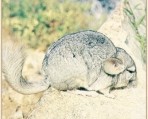
Wild Chinchilla |
Females can have up to two litters per year. When
compared to other rodents, chinchillas have a long
gestation periods resulting in few offspring.
Chinchillas are nocturnal and live in colonies. Two
species of chinchillas are recognized as: Chinchilla
brevicaudata (Blue Bolivian Chinchilla), and
Chinchilla lanigera (Lanigera) (Nowak, 1991; Jiménez,
1996).
Exploitation for the fur trade to markets in
Europe and North America started by the onset of the
19th century and demand for the pelts continues today.
Requiring a hundred pelts per coat, this fur is among
the most expensive and rarest in the world. "In 1928,
a coat made of Bolivian pelts cost half a million gold
marks" (Bickel, 1937). In 1992, a domestic chinchilla
fur coat on
sale at Elan Furs (Indianapolis, Indiana) cost
$22,000.
The chinchilla population declined steadily
because of hunting and trapping. At the end of the
nineteenth century, the once abundant animals had
become endangered. Humans were hunting and trapping
the animal for its fur faster than the animal could
repopulate themselves resulting in scarcity of the
species. According to Meadow (1969), "the
disappearance of the once
beautiful chinchilla alarmed the South American
governments of Chile, Peru, Bolivia, and Argentina.
By 1918 all of them had placed an embargo on
exportation of chinchilla furs, and had laws against
trapping the animal."
Of the 21 million killed, Iriarte (1986) reports
that 7,179,640 pelts were exported from Chile between
1828 and 1916 (Jiménez, 1994). Chile enacted
protection in 1898 but protection from hunting was
probably too late for the existing wild populations
(1994, Thornback, 1969).
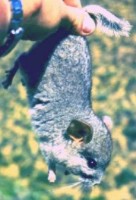
Wild Baby | Any existing (or surviving) chinchillas were
included among the endangered wild species mentioned
in Appendix I of the 1973 Convention on International
Trade in Endangered Fauna and Flora" (Stehnke, 1990;
Nowak, 1991; Thornback, 1969). CITES places a ban on
the exportation and importation of the animals and
their pelts among agreeing countries. Although wild
chinchillas' range once extended to Peru and Bolivia,
it is now extinct there (Thornback, 1969; Jiménez,
1994). In Chile, wild chinchillas are listed as
endangered (CONAF, 1988). |
As early as 1937, people recognized chinchilla
populations had been severely altered but could
probably "re-establish itself in 7 or 8 years"
(Bidlingmaier, 1937). Since Reserva Nacional Las
Chinchillas- CNR's establishment 15 years ago, the
animal has not re-established itself.
Populations within the reserve continue to decline
without clear explanations (Jiménez, 1994).
How fast can the animal reproduce and achieve
recruitment? If a mated pair has two offspring, which
survive in their first litter, replacement of the
original pair has occurred. Any additional offspring
are seen as recruitment or population growth.
Recruitment leads to higher populations, our optimal
goal.
C. lanigera's original range included the
foothills of the Andes in Chile from northwest of
Potrerillos south to Rio Choapa (1996). Wild C.
lanigera was thought to be extinct (Noguer, 1970). In
the mid-seventies, this species was rediscovered in
providence IV, Region de Coquimbo, Chile. To protect
these colonies, Corporacion Nacional Forestal -CONAF
(the Chilean Park Service) established Reserva
Nacional Las Chinchillas-CNR in 1983.
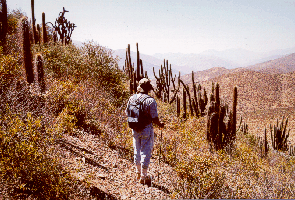
Work Site | Today, two disjunct populations of C. lanigera
are located in this region of Chile. The northern
distribution near La Serena has one colony
encompassing 46 ha (Jiménez, 1995). Located two
hundred fifty km south near Illapel are approximately
40 colonies (1995). |
These colonies house fewer than
4000 chinchillas (recalculated from Jiménez, 1995).
Less than half of the known colonies are within the
reserve. Sixty percent of the colonies "had less than
50
individual whereas none had more than 500 individuals"
and covered from fewer than two to more than 113 ha
(1995). Most colonies are located on northern facing
slopes but rocky southern slopes also host some
chinchillas.
Central Chile is geologically complex. In this
region coastal mountains meet the Andean Range. These
are crossed by transverse mountain chains. Topography
changes abruptly and the sandy foothills of the Andes
prove to be a difficult terrain for humans to climb.
The area is dissected by an meandering intermittent
river channel that is dry most of the year. This area
is a
semi-desert biome with two distinct seasons: a dry hot
season and a mild wet season. Annual rainfall between
1980 and 1996 averaged 18 cm, most occurring during
the winter wet season of June, July and August.
Vegetation assemblages are characteristic of semi-arid
and Mediterranean climates and include many cacti and
succulent species (Veliz, 1985).
| Most Chinchillas burrow to create tunnels within
the Puya berteroniana, card˘n plant (Mohlis, pers.
comm. 1995). A succulent, terrestrial bromiliad,
card˘n can be found on equatorial slopes. Practices
of trying to encourage, entice or force chinchillas
out of their protective burrows led to the destruction
of habitat. Chinchilleros (chinchillas trappers) used
smoke, fire
and explosives "to drive chinchillas out of their
burrows" (Jiménez, 1995). Disturbing their habitat
can increase the animals stress and place the animal
in alert and defensive behaviors. This disruption
reduces the amount of energy and time chinchillas have
for rest and reproduction. Furthermore, structural
damage to burrows can block tunneling systems which
the animal depends upon for safety when escaping from
natural predators which include foxes and birds of
prey. A small proportion of chinchillas live in
crevices among rocks. |
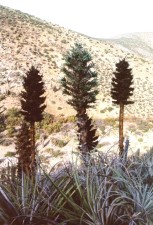
Puya |
Passive management techniques have apparently not
resulted in increased chinchilla populations.
Successful conservation programs must utilize active
management techniques in order to encourage increases
in recruitment.
Fragmented habitat leaves gaps which prevent
dispersal and expansion of chinchillas and colonies.
Intra-colony gene flow must be possible in order for
the species to survive. This exchange of genetic
material is more likely to occur in areas where the
species does not have to cross unprotected or hostile
barriers in order to reach potential mates. Practices
of revegetation can reduce barriers to genetic flow
encouraging recruitment eventually resulting in higher
populations. Actively creating habitat aids in
conservation of this species by reducing competition
and barriers while increasing available resources.
Clearing land for hunting, mining and farming has
resulted in habitat fragmentation as well as
degradation. Practices of revegetation should try to:
close gaps in distributions, increase habitat and
reduce competition. Restoration efforts of chinchilla
habitat began in 2000 and continue today. The focus
of re-vegetation is to plant seedlings and broadcast
seeds that will complement and expand colonies and
their interconnections or corridors.
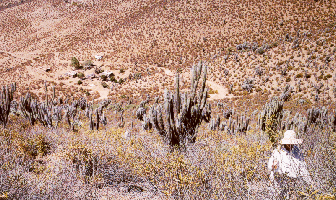
Work Site |
Preservation and expansion of protected lands
must continue in order to facilitate conservation
efforts. Special ecological areas need protection
from human disturbances if endangered animals are
going to survive. |
Expansion of protected habitat must
be planned, evaluated and carried out on an ongoing
basis.
Save the Wild Chinchillas, Inc. is a
not-for-profit organization formed to aid in
conservation of wild chinchillas. Its goal is to
ensure that these endangered animals do not become
extinct. In order to meet this goal we have three
objectives: educate people of all ages, collect funds
to buy land and create preserves, and promote studies.
Members of Save the Wild Chinchillas actively creates
habitat by collecting seeds, growing plants in
nurseries and restoring vegetation, visit schools and
provide current and correct information to both
teachers and students locally in Chile and worldwide.
Members have conducted scientific studies not only for
school projects but also for the Chilean Parks
Service. The latest study based on data collect by
the Chilean Parks service detected a 15% decrease of
the wild chinchilla population since 1996.
Bibliography
Bickel, E. Sudamerikanische CHINCHILLAS, Wie man sie
halt und zuchtet. Trans. U. Erich Friese. Chinchilla
Handbook. 6th ed. Neptune City: T.F.H. Publications,
Inc., 1987.
Bidlingmaier, T.C. (1937). Notes on the genus
Chinchilla. Journal of Mammalogy, 18, 159-163.
"Chinchilla." Walker's Mammals of the World. Ed.
Robert M. Nowak. 5 th ed. Baltimore and London: The
John Hopkins University Press, 1991.
CONAF-Corporacion Nacional Forestal. Brochure of
endangered Chilean mammals. Santiago,1988.
El mundo de los animales. Ed. Noguer. 2 ed. Milan:
Rizzoli, 1970.
International Union For Conservation Of Nature And
Natural Resources. "Long-Tailed Chinchilla." The IUCN
Mammal Red Data Book Part 1. Ed. J. Thornback. Gland:
IUCN, 1984.
Iriarte, J.A. and Jaksic, F.M. (1986). The fur trade
in Chile: an overview of seventy-five years of export
data (1910-1984). Biological Conservation, 38,
243-253.
Jiménez, J.E. (1990). Proyecto conservacion de la
chinchilla chilean (Chinchilla lanigera), CONAF-WWF
1297. Final report, March 1987 -February 1990.
Corporation Nacional Forestal, Illapel, IV Region,
Chile.
Jiménez, J.E. (1994). Overuse and endangerment of
wildlife: the case of Chilean mammals. Medio Ambienta
(Chile), 12, 102-110.
Jiménez, J.E. (1995). Conservation of the last wild
chinchilla (Chinchilla lanigera) archipelago: a
metapopulation approach. Vida Silvestre Neotropical,
4(2):89-97.
Jiménez, J.E. (1996). The extirpation and current
status of wild chinchillas Chinchilla lanigera and C.
brevicaudata. Biological Conservation, 77:1-6.
Meadow, Harold. The Chinchilla. Redwood City: The
Tozer Co., 1969.
Mohlis, C.(1983) Informacion preliminar sobre la
coservacion y manejo de la chinchilla silvestre en
Chile. Boletin Tecnico No.3, Santiago. Corporation
Nacional Forestral, Santiago.
Mohlis, Connie. Phone interview. December 1995.
South American Handbook. Ed. B. Box. 3rd ed. Chicago:
Passport Books, 1996.
The International Wildlife Encyclopedia. "Chinchilla."
Ed. M. Burton and R. Burton. 4 th vols.New York:
B.P.C. Publishing Limited, 1969.
Veliz, J.R. Geografia de Chile. Santiago:
Publicaciones Lo Castillo S.A., 1985.
Walker's Mammals of the World. Chinchillas Ed. R. M.
Nowak. 5 th ed. Baltimore and London:The John Hopkins
University Press, 1991.
If after reading this article you would like to contribute to Save the Wild Chinchillas, Inc.
please click here
|
|
|